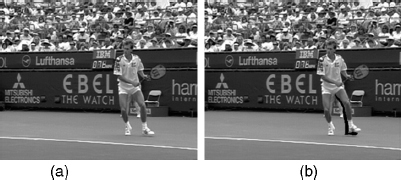5.6 Spatio-temporal Scene-level Error Concealment for Segmented Video
(Portions reprinted, with permission, from G. Valenzise, M. Tagliasacchi, S. Tubaro, L. Piccarreta, “A rho-domain rate controller for multiplexed video sequences”, 26th Picture Coding Symposium 2007, Lisbon, November 2007. ©2007 EURASIP.)
5.6.1 Problem Definition and Objectives
As referred to in Section 5.5, several object-based error-concealment techniques, dealing both with shape and texture data, have been proposed in the literature. These techniques, however, have a serious limitation in common, which is that each video object is independently considered, without ever taking into account how it fits in the video scene. After all, the fact that a concealed video object has a pleasing subjective impact on the user when it is considered on its own does not necessarily mean that the subjective impact of the whole scene, when the objects are put together, will be acceptable; this represents the difference between object-level and scene-level concealment. An example of this situation is given in Figure 5.7, where a hole has appeared as a result of blindly composing the scene by using two independently-concealed video objects.

Figure 5.7 Illustration of a typical scene-concealment problem: (a) original video scene; (b) composition of two independently error-concealed video objects. Reproduced by Permission of ©2008 ...